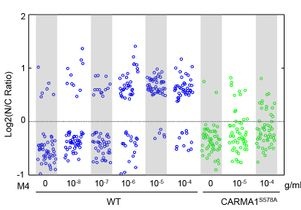B cells produce antibodies 'when danger calls, but not when it whispers,' scientists report
20 May 2014
The immune system's B cells protect us from disease by producing antibodies, or "smart bullets," that specifically target invaders such as pathogens and viruses while leaving harmless molecules alone. But how do B cells determine whether a threat is real and whether to start producing these weapons?
An international team of life scientists shows in the May 16 issue of the journal Science how and why these cells respond only to true threats.
 | |
| Graph of B cell reactions: The threshold is 0, and under normal circumstances the B cells, shown in blue, either clearly exceeded it or failed to reach it. But when the circuit was altered, many of the B cells, in green, fell just slightly above or below the threshold (Japan's RIKEN Center for Integrative Medical Sciences) |
"It is critical for B cells to respond either fully or not at all. Anything in between causes disease," says the study's senior author, Alexander Hoffmann, a professor of microbiology, immunology and molecular genetics in the UCLA College of Letters and Science. "If B cells respond wimpily when there is a real pathogen, you have immune deficiency, and if they respond inappropriately to something that is not a true pathogen, then you have autoimmune disease."
The antibodies produced by B cells attack antigens - molecules associated with pathogens, microbes and viruses. A sensor on the cell's surface is meant to recognize a specific antigen, and when the sensor encounters that antigen, it sends a signal that enables the body's army of B cells to respond rapidly. However, there may be similar molecules nearby that are harmless. The B cells should ignore their signals - something they fail to do in autoimmune diseases.
So how do the B cells decide whether to start producing antibodies?
"These immune cells are somewhat hard of hearing, which is appropriate because the powerful and potentially destructive immune responses should jump into action only when danger calls, not when it whispers," said Hoffmann.
The B cells make their response only when a rather high threshold is reached, Hoffmann and his colleagues report. A small or moderate signal - from a harmless molecule, for instance - gets no response, which reduces the risk of false alarms.
"It's like your car's airbag, which won't be deployed unless you really need it," Hoffmann said. "You can imagine that if the airbag were poorly designed and if you brake very hard or have a slight accident, it could deploy slowly and be useless. You want it to deploy fully or not at all. That is what the B cell does when deciding whether it confronts something that is truly pathogenic or harmless. No B cell responds partially."
We have billions of B cells, and each one creates this threshold through a molecular circuit involving two molecules. One of these molecules, known as CARMA1, activates the other, IKKb, which further activates the first one.
"Positive feedback between the two causes infinite growth, and once you trigger it, there is no way to turn it off until the smart bullets are shot," said Hoffmann, whose research aims to understand and decode the language of cells. "But a second feature of positive feedback is that it can create a threshold only above which this runaway activation occurs."
He and his colleagues developed mathematical equations based on the molecular circuit and were then able to simulate, virtually, B cell responses. The team's resulting predictions were tested experimentally by their collaborators at the Laboratory for Integrated Cellular Systems at Japan's RIKEN Center for Integrative Medical Sciences. In one part of the study, the researchers made specific mutations in IKKb so that it could not signal back to CARMA1. They also made mutations in CARMA1 to prevent it from receiving the signal from IKKb. In both cases, the B cells responded partially, some of the time, like a weakly inflating airbag.
"It became a gray-zone response rather than a black-and-white response," said Hoffmann, who constructs mathematical models of biology.
The research could lead to better diagnosis of disease if patients with an autoimmune disorder, such as lupus, have a defect in this molecular circuit.






























